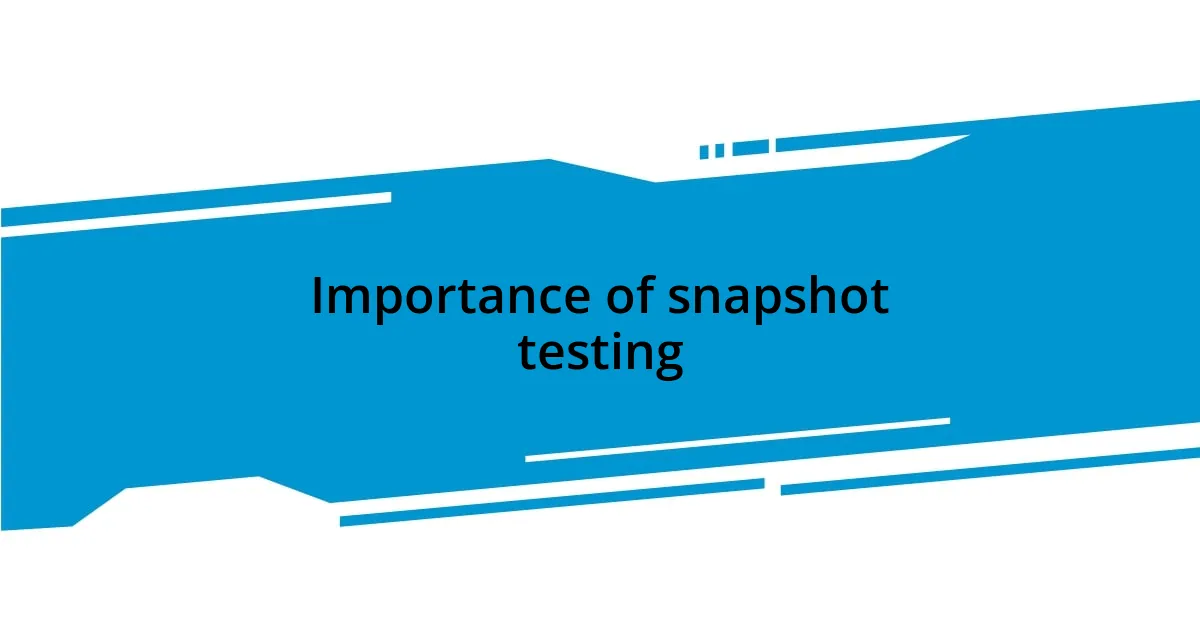Key takeaways:
- Snapshot testing enhances UI consistency and fosters a culture of quality within development teams.
- It’s vital to set up and maintain snapshot testing effectively, focusing on clear documentation and regular reviews.
- Collaboration in snapshot updates improves team dynamics and deepens understanding of the UI’s evolution.
- Developers should avoid complacency and not rely solely on snapshots; comprehensive tests for functionality are essential.

Overview of snapshot testing
Snapshot testing is a valuable technique I’ve come to appreciate in my development workflow. It allows me to capture the output of a component and store it as a “snapshot,” which I can refer back to later. This method offers a safety net, ensuring that any changes in the component’s output are easily identified over time.
I remember the first time I implemented snapshot testing in one of my projects. I was skeptical at first—could a simple text comparison really catch all the nuances of UI changes? However, the peace of mind it provided me when revisiting the components was eye-opening. It streamlined my code review process and improved communication with my team about UI expectations.
With snapshot testing, I’ve learned that it’s not just about detecting changes; it’s also about validating intent. When I reflect on my experiences, it prompts me to think: How can I be more deliberate in crafting my components? This approach has deepened my understanding of UI consistency and improved the overall quality of my applications.

Importance of snapshot testing
The importance of snapshot testing extends far beyond merely catching bugs; it’s about fostering a culture of quality. When I first began using snapshot tests, I realized they helped me articulate my expectations for UI behavior. This clarity not only enhanced my code’s reliability but also created a shared understanding within my team. Have you ever had a moment where a small change turned into a bigger issue? That’s where snapshot testing shines—it prevents misunderstandings from snowballing into significant problems.
One aspect I truly value is how snapshot testing saves time during code reviews. In my experience, instead of manually inspecting changes line-by-line, I can quickly refer to a visual comparison of the old and new snapshots. This allows me to focus on more complex discussions with my colleagues rather than getting caught up in minor discrepancies. It also opens up opportunities for collaboration: team members can weigh in on design decisions right from the snapshots, reinforcing a more cohesive product vision.
Furthermore, snapshot testing promotes accountability in our development process. If I notice something off during my review, it’s a gentle reminder to reassess my own code practices. I remember once pushing a new feature only to discover a snapshot mismatch due to an overlooked detail. It was a humbling experience but one that reinforced the value of proactive testing. The emotional insight it left me with is a commitment to continuous improvement—not just for myself but for the entire team.
| Aspect | Benefits |
|---|---|
| Quality Assurance | Helps teams establish a solid standard for UI consistency and behavior. |
| Efficiency in Reviews | Streamlines code reviews by highlighting visual differences instead of manual checks. |

Setting up snapshot testing
Setting up snapshot testing might seem daunting at first, but I’ve found it to be quite straightforward with the right tools. When I first set it up in my project, I recall feeling a mix of excitement and a pinch of apprehension. Would it really make a difference? To ease into it, I focused on integrating snapshot testing into my existing workflow gradually.
Here’s a quick guide to help you get started:
- Choose a Testing Library: Start with popular options like Jest or Mocha, which have snapshot capabilities built-in.
- Install Dependencies: Make sure to install the necessary packages to support snapshot testing in your project. I use npm for this, as it’s simple and familiar.
- Create a Snapshot: Write your first test that renders a component and generates a snapshot. The first time you run it, the snapshot will be created automatically, and I found that moment to be quite rewarding.
- Run Tests Regularly: Incorporate snapshot tests into your regular testing routine to catch changes early. I recall the relief I felt when unexpected changes were flagged before going into production.
- Review and Update Snapshots: Always review snapshots generated and update them only when necessary. This helps avoid potential issues with unintentional changes sneaking into your components.
Engaging with snapshot testing from this foundational level has transformed the way I perceive component integrity. It feels like having a constantly updated safety net—a tangible reminder that I’m taking control over my code’s evolution.

Writing effective snapshot tests
Writing effective snapshot tests requires a blend of clarity and precision. I’ve learned that it’s crucial to focus on the components most likely to change or that are foundational to your application. One time, I chose to create snapshot tests for a complex navigation component that had multiple states. I was pleasantly surprised at how quickly I could identify visual regressions, validating that I’m spending my time where it matters most.
Another key aspect is maintaining a clean snapshot repository. Over time, I’ve found that regularly reviewing and pruning outdated snapshots not only keeps things manageable but also reinforces my understanding of the code. I remember a period when I neglected this practice; it snowballed into confusion where outdated snapshots were being mistakenly referenced in reviews. Have you ever felt overwhelmed by too many files? I can assure you, simplifying your snapshots can elevate your workflow significantly.
Lastly, remember that the goal is to document your UI’s evolution, not to create chaos. I advocate for thoughtful updates—updating snapshots should be a conscious decision, not a routine task. When I made this shift in mindset, it transformed how I approached my tests. Now, I find joy in discussing the intent behind changes with my team, creating a more inclusive and engaging environment. How about you? Are you ready to see snapshot testing as a collaborative journey rather than just another chore?

Best practices for snapshot testing
When I think about best practices for snapshot testing, one crucial aspect is ensuring that your tests are quick and reliable. The initial thrill of seeing snapshots pass can quickly turn into frustration if tests take too long or, worse, give false positives. I’ve found it invaluable to focus on testing smaller, more isolated components first. This way, you can avoid overcomplicating your tests and make troubleshooting easier. Are you nodding along? It’s easier to refactor quickly when you can pinpoint which snapshot test is failing without sifting through a labyrinth of components.
Another practice I swear by is to write descriptive test names. I remember a time I ended up with snapshots labeled vaguely—like Component.test.js. It was a headache when trying to recall the context of each snapshot during reviews, leading to unnecessary confusion. Now, I aim for names that explicitly describe what’s being tested, making it user-friendly for myself and my teammates. Isn’t it a relief to have clarity when navigating through code? You’ll find that descriptive names enhance collaboration too, fostering a culture where everyone feels equipped to engage with the tests.
Lastly, I can’t stress enough how valuable it is to involve your team in the snapshot update process. Early on, I approached updates as a solo task, which often led to missed opportunities for discussion and insights. When I started reviewing snapshots as a team, I was amazed at the different perspectives and questions that emerged. Have you ever experienced a “lightbulb moment” when collaborating? Sharing the reasoning behind changes can deepen the understanding of your UI and build a stronger team dynamic. Trust me, embracing collaboration in this area can create a ripple effect, encouraging a healthier approach to testing.

Common pitfalls in snapshot testing
One common pitfall I’ve encountered in snapshot testing is complacency. It’s easy to fall into the trap of believing that once you have a snapshot that works, it will always be valid. I recall a time when I had a snapshot for a button component that looked perfect—until we redesigned the button style completely. When I finally ran the tests after the redesign, it was shocking to see how outdated and unhelpful my snapshots had become. Have you ever overlooked snaps like that, thinking they were forever reliable?
Another mistake involves snapshots becoming a crutch for poor testing practices. I’ve seen developers rely solely on snapshots instead of writing comprehensive tests for functionality. I remember initially thinking that having a large number of snapshots meant I was thorough, only to realize that important edge cases were left unchecked. It’s a harsh lesson: snapshots can’t replace thoughtful unit and integration tests. What about your experience? Do you sometimes find yourself leaning too heavily on snapshots?
Lastly, there’s the temptation to ignore the significance of visual regressions captured in snapshots. When I first started, I had a habit of treating snapshot failures as minor annoyances, often brushing them off without deeper investigation. But I’ve learned that each snapshot reflects a part of the user experience, and neglecting those failures can lead to a degraded UI. Have you ever dismissed a snapshot failure, only to find later that it actually mattered? Embracing each failure as a learning opportunity has been pivotal in my growth as a developer.

Analyzing snapshot test results
Analyzing snapshot test results can initially feel overwhelming. I remember the first time I reviewed my snapshot outputs; it felt like deciphering a secret code. Each failing snapshot seemed to taunt me with its ambiguity. Over time, I learned to embrace the results as essential feedback rather than just a frustrating roadblock. Asking myself, “What specifically changed here?” became my mantra, guiding me towards deeper insights.
It’s also crucial to scrutinize what exactly failed within the snapshot. One time, I noticed that formatting changes in a component inadvertently caused a series of snapshots to fail. Instead of blaming the tool, I took a step back and examined the component’s structure. This shift in perspective not only resolved my immediate issue but also helped me develop a keener eye for potential pitfalls in future designs. Have you ever had a similar experience where a small fix opened up a whole new understanding?
Finally, it’s important to consider the context of your snapshots. When I first started, I approached each situation without recognizing how changes in one component could ripple through others. One memorable instance involved a minor text change in a header, which unexpectedly led to multiple snapshot failures in child components. This taught me the importance of analyzing the overall architecture when a test fails. Have you ever stopped to examine the network of components, realizing that a single change can have significant repercussions? This kind of analysis has fundamentally changed how I approach snapshot testing, helping me catch issues early on.














